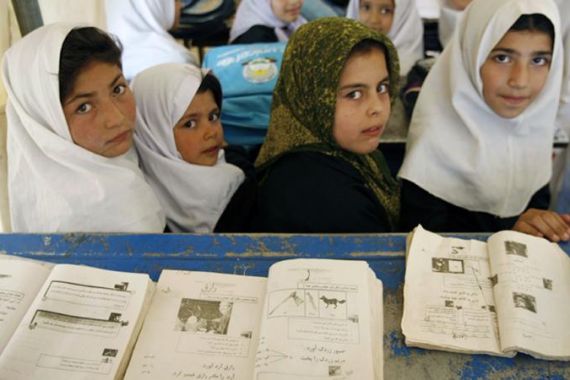The changing face of Afghan education
Considerably improved access to education is one of the most dramatic social changes in the last decade in Afghanistan.

The constant but quiet chattering comes from the group of girls sitting on manicured lawns in the front yard of Tajrabawl High School in Herat city, Afghanistan. Giant pine trees shade them from the stifling summer heat. It is 10am and already 40 degrees Celsius.
The girls are keeping their voices down because inside their classmates are finishing off mid-term exams.
All are immaculately dressed in a uniform of a white headscarf and black full-length dress. The school is spotless. Murals on the walls depict verses from ancient Afghan poets alongside scientific equations.
Outside the head teacher’s office two cabinets display some of the best handicrafts that the girls have made. There is a computer room connected to the internet. Next-door is a modest science and biology lab. The classroom doors are open to try and generate a draught to relieve the heat.
All I can hear is the occasional scraping of a chair on the floor, or a stifled cough.
Inside the classrooms rows of girls are hunched over exam papers, chewing pens, thinking then writing down answers. It is the stuff of schools all over the developed and developing world. But I didn’t expect to see it in Afghanistan.
Perhaps I should not have been so surprised. Considerably improved access to education, especially for women, is perhaps one of the most dramatic social changes in Afghanistan in the last 10 years.
The country’s education ministry says 2.5 million women are enrolled in school. Ten years ago 900,000 children were in school, almost all of them boys.
But there is still a long way to go.
Only one in five women can read or write according to UNICEF, and that figure varies considerably province by province. In the dangerous south of the country just 2 per cent of women are literate. In places where the Taliban holds influence, particularly the east, girls’ schools can still be forced underground.
Nationwide just 32 per cent of all secondary school age children are actually enrolled, according to government figures. But, where there is better security there seems to be an unquenchable thirst for education.
Tajrabawl High School operates in three shifts to accommodate its 3,500 students. The first shift arrives a 6:30am and the last shift leaves at 6:00pm.
The headteacher, Basira Basiratkhwa, says she needs more classrooms. She would also like to pay her teachers more. They earn just US$120 to US$190 per month. But otherwise she is very happy with her school.
Mrs Basiratkhwa is talking to me on the front steps of the main building. Hands clasped at her waist she wears an expression on her face that suggests a certainly firm but fair approach to her girls.
To me it is the standard headmistress expression adopted the world over. Cheekily I suggest to Mrs Basiratkhwa that the school must be noisy with chatter when there aren’t exams to concentrate young student minds.
She fixes me with a stare, “not in this school” she says, a hint of a smile flashing across her face.
|
|